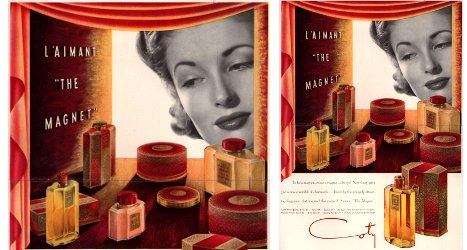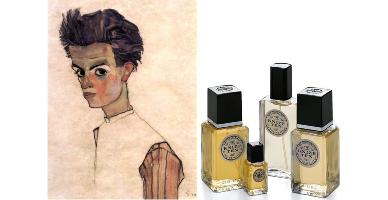A beautifully shot 5 minute tour through the life of François Coty, including some great vintage-perfume-bottle porn. For the bigger picture, read Perfume and Politics in the May 3, 1930 New Yorker.
Coty L’Aimant ~ fragrance review

“Look what I found for you,” my coworker said and handed me a Coty L’Aimant perfume ad shrink-wrapped on cardboard. It was all in gold and red, featuring a woman in a 1950s coiffure gazing into a tiny stage peppered with various L’Aimant products, from perfume to compacts to body powder. Each product was adorned with a horseshoe magnet encompassing a heart. “To be a magnet — wear a magnet — always!” the copy said.
Well, I could use some magnetizing. Who couldn’t? I remembered the bottle of vintage L’Aimant Eau de Toilette stashed in my perfume cupboard. It was time to put it to the test.
François Coty and Vincent Roubert created L’Aimant over five years, and the fragrance launched in 1927 — for context, the same year that saw the birth of Lanvin Arpège, Caron Bellodgia, and Jean Patou Chaldée. In his book Perfume, Nigel Groom lists L’Aimant’s notes as bergamot, neroli, peach, strawberry, jasmine, rose, ylang ylang, vanilla, vetiver and sandalwood. The fragrance fell out of production, then relaunched in 1995, when Groom claims it became the most popular perfume in Great Britain…
Knize Ten ~ fragrance review

I bought my first bottle of the Knize Ten during a particularly long (and chilly) wet season in Los Angeles, and I remember walking to and from work for weeks — wearing Knize Ten — on streets lined with blooming jacaranda trees, their strongly perfumed blue flowers drenched with rain. Today, in Seattle, rain isn’t rare as it was in usually parched and sunny L.A., but Knize Ten still blends well with cool, stormy weather.
The Viennese clothing firm Knize has been around since 1858, and it introduced its first fragrance, Knize Ten, in 1924. (Knize used images of polo players in its advertising, and “ten” is the highest handicap in polo.) There’s no doubt Knize Ten has been through some reformulations* in the last 86 years (its leather and musk notes have been softened considerably since I wore it 15 years ago), but it still possesses a crisp, “classic” vibe; it’s a debonair, spicy-floral leather fragrance…
Snippets: Coty & Truffles
Francois Coty, a master of marketing, knew how to get a girl's attention.
"Give a woman the best product you can compound, present it in a perfect container (beautifully simple, but of impeccable taste), charge a reasonable price for it and a great business will arise such as the world has never seen," wrote the Corsican-born perfumer in 1906.
— Message in a bottle, in The Age, looks at perfume packaging and how today's perfumes are "dressed for success".
A TRUFFLE by any other name may smell as sweet, but what if that name is 2,4-dithiapentane? All across the country, in restaurants great and small, the “truffle” flavor advertised on menus is increasingly being supplied by truffle oil. What those menus don’t say is that, unlike real truffles, the aroma of truffle oil is not born in the earth.
— It isn't about perfume, but Hocus-Pocus, and a Beaker of Truffles, from The New York Times, will resonate with perfume fans who wonder how much of what they smell is "real".
More perfume reading from the New Yorker
I completely missed it the first time, but if you look at the tiny print next to the Jean Claude Ellena article in the New Yorker, there is a link to a 1930 profile of perfumer Francois Coty. It is a fascinating article in its own right, and also a nice illustration of how much the perfume industry has changed since Coty's time.